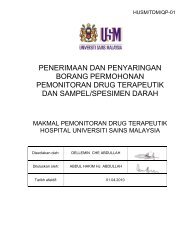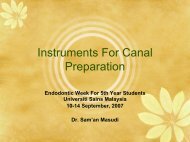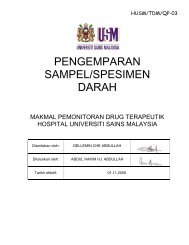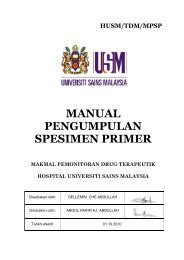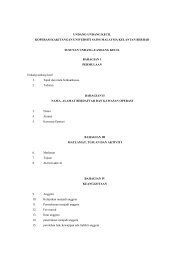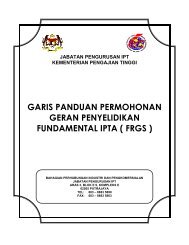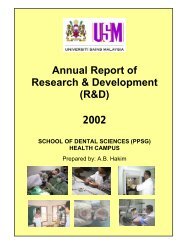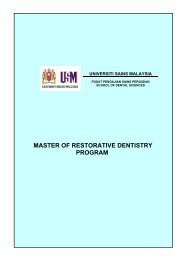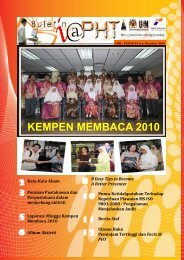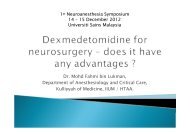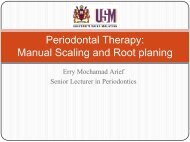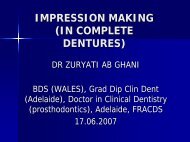Cementation of FGC
Cementation of FGC
Cementation of FGC
Create successful ePaper yourself
Turn your PDF publications into a flip-book with our unique Google optimized e-Paper software.
<strong>Cementation</strong><br />
Dr Adam Husein<br />
2008
Lecture Outline<br />
• Pre-cementation<br />
• Removal <strong>of</strong> temporary crown<br />
• Try-in<br />
• Cements<br />
• Review or recall appointments
<strong>Cementation</strong> Procedures<br />
KEY ISSUES<br />
• Inspection <strong>of</strong> restoration<br />
• Status <strong>of</strong> temporary<br />
restoration<br />
• Tooth response<br />
• Trial fitting<br />
• Occlusal adjustments<br />
• Selection <strong>of</strong> luting agent<br />
• Familiarity with luting agent<br />
• <strong>Cementation</strong> technique<br />
• Polishing and Finishing
Pre-insertion Inspection <strong>of</strong><br />
Restoration<br />
What to look for<br />
• Have lab instructions been followed<br />
• Is the design <strong>of</strong> restoration as prescribed<br />
• Shape <strong>of</strong> restoration/ marginal fit/ stability on die<br />
• Flaws in restoration (chip, crack, voids, perforations)<br />
• Scratches on die, damage to die
Pre-cementation<br />
• Ensure the correct crown<br />
• Check on the model<br />
– No distortion <strong>of</strong> the model<br />
–Good fit<br />
–Margins<br />
– Stability<br />
– Contact points<br />
– Polish<br />
• Disinfect with chlorhexidine
Pre-cementation<br />
• In the mouth<br />
–Temporary crown<br />
–Symptoms<br />
– Remove temporary crown<br />
• Carver<br />
• Crown removal or puller<br />
– Check the prep<br />
– Remove temporary cement<br />
• Pumice and brush, ultrasonic scaler
Consequences <strong>of</strong> a Lost Temporary<br />
Restoration<br />
• Tooth sensitivity<br />
• Bacterial ingress/ pulpitis<br />
• Proximal tooth drift<br />
• Over-eruption prepared tooth<br />
• Eruption <strong>of</strong> opposing tooth<br />
• Compromised appearance<br />
• Prep prone to damage
Assessing Status <strong>of</strong> Temporary<br />
Restoration<br />
• Tooth sensitivity (post-prep, lingering, intermittent)<br />
• Dislodgement (recent, long-term)<br />
• Breakage<br />
• Comfort<br />
• Function, aesthetics<br />
• Gingival response
Temporary Restoration Removal<br />
• ? Place LA<br />
• Spoon excavator<br />
• Crown puller<br />
• Section <strong>of</strong>f<br />
• Ultrasonic<br />
• Patient’s nasogastric passage must be protected
Release<br />
weight<br />
Push down<br />
weight<br />
Berekally, 2003
Temporary Cement Removal<br />
• Instrument (carver, excavator tip, scaler)<br />
• Cotton pledget soaked in Chlorhexidine solution<br />
• Ultrasonic tip<br />
* If tooth is sensitive LA may be required
Trial Insertion<br />
• Hold restoration in dry gloves<br />
• Turn patients head to side <strong>of</strong> insertion<br />
• Have large suction on standby<br />
• Tight proximal contacts may prevent<br />
seating <strong>of</strong> restoration<br />
• Undercuts and very parallel prep walls<br />
may prevent seating<br />
• Flaws in restoration fitting surface may<br />
prevent seating<br />
• Inaccurate impression/die may have led to<br />
construction <strong>of</strong> a tight or loose fitting<br />
restoration
Safety Precautions<br />
• Inhaled<br />
– Serious medical emergency<br />
– The patient should be rapidly inverted and<br />
encouraged to cough<br />
• If unsuccessful – hospital<br />
• Swallowed<br />
– Less dangerous<br />
– Usually need radiograph<br />
– Advise patient to recover the crown<br />
• Sieve and running water (Smith, 2000)
Safety Precautions<br />
• Dry gloves<br />
• Isolate the tooth<br />
• Keep a finger on the crown all the time<br />
• High volume suction ready<br />
• Gauze behind the crown<br />
• Treat patient in upright position<br />
• Rubber dam – may not be practical
Pre-cementation<br />
• Try in the crown<br />
–Fit<br />
– Contact points<br />
– Stability<br />
–Resistance<br />
–Margins<br />
–Occlusion<br />
• Ensure all fine before cementing<br />
• No adjustment post cementation
Try-in<br />
• Marginal fit<br />
• Retention<br />
• Contact Points and Axial Contours<br />
• Shade<br />
• Occlusion
Marginal fit<br />
• Eye and sharp probe<br />
• Gaps<br />
– A uniform gap all the way round indicates that<br />
the crown is not fully seated<br />
• Retained temporary cement<br />
• Trapped gingival tissue<br />
• Contact points<br />
• Overhang (positive ledge)<br />
• Deficiencies (negative ledge)
Checking contact points<br />
Rub pencil marks on teeth adjacent to crown. If the crown does not seat<br />
fully the dark pencil marks will be seen at the points <strong>of</strong> binding on the<br />
crown’s proximal surfaces. On removal these points are adjusted and<br />
The trial seating process repeated until fit is accurate
Adjustment and polish
Artispot, a red vegetable dye in acetone can be used to mark the fitting surface <strong>of</strong> crowns<br />
binding spots are coincident with spots <strong>of</strong> exposed alloy surface. The corresponding<br />
tooth surface is also marked with red dye. Usually the crown is altered first. But if there<br />
Is a risk <strong>of</strong> perforation it may be necessary to minimally alter the tooth
GC Fit Checker is a silicone material (mixed via a base = catalyst pastes) and applied<br />
to the restoration fitting surface and seated on the tooth. After 60 seconds the crown<br />
can be removed and high spots may be seen via exposed alloy. These spots are<br />
marked with a pencil, the silicone removed and then adjustments carried out with a<br />
small abrasive stone.
Caliper – measuring crown thickness
Retention<br />
• A crown should not feel tight. Tight crowns may<br />
be more difficult to cement, resulting in an open<br />
margin<br />
• Tilting<br />
– Unretentive design<br />
– Excessive use <strong>of</strong> die relief/spacer<br />
• Pivot<br />
– Not fully seated<br />
– Contact points<br />
– High spots on the fit surface
Contact Points and Axial Contours<br />
• Dental floss<br />
– Neither too tight nor too slack<br />
• Buccal and lingual contours – not too bulbous<br />
• Marginal area – in line with the tooth surface<br />
– Reduce plaque retention<br />
– Natural appearance<br />
• Remove/add materials and repolishing/glazing
Shade<br />
• Too light (too low chroma) – can be<br />
darkened by adding stain and refiring<br />
– Stain can also be used to add missing<br />
characteristics such as crack lines or mottled<br />
areas<br />
• Wrong basic hue or too dark chroma or<br />
wrong colour <strong>of</strong> the opaque core material<br />
or the dentine porcelain – not possible to<br />
correct – redo
Occlusion<br />
• Reorganized<br />
• Confirmative<br />
–ICP<br />
– Lateral, protrusive and retrusive<br />
• Articulating paper<br />
• Occlusal wax<br />
• Shimstock or mylar matrix strip<br />
• Remove/add material<br />
• Repolish/glaze
Problems and Solutions at Trial Insertion<br />
PROBLEM<br />
Cannot seat crown<br />
Occlusal contact high<br />
Occlusal deficiency<br />
Poor fit (margins, rocking)<br />
Unsatisfactory shade<br />
SOLUTIONS<br />
Adjust proximal contacts<br />
Alter taper <strong>of</strong> prep<br />
Alter fitting surface <strong>of</strong><br />
restoration<br />
New impression/ remake<br />
Adjust with abrasive stones<br />
Addition <strong>of</strong> resin/porcelain<br />
Alloy augmentation not possible<br />
Retake impression/remake<br />
Remake restoration<br />
Remake without impression<br />
Alter shade in lab with low<br />
fusing<br />
ceramic addition<br />
Alter shade with indirect resin
Choice <strong>of</strong> Cements<br />
• Temporary Cement<br />
• Zinc phosphate<br />
• Zinc Polycarboxylate<br />
• Glass Ionomer Cement<br />
• Resin-Modified GIC<br />
• Compomer (Polyacid-modified resin)<br />
• Resin Cement
Zinc Phosphate Cement<br />
• Good film thickness (< 25µ)<br />
• Poor strength<br />
• High solubility<br />
• Nil chemical adhesion<br />
• Easy to use<br />
• Minimal sensitivity
Poly-F
Polycarboxylate Cements<br />
• Adhesion to enamel/dentine<br />
• Well tolerated by pulp<br />
• Mix is sticky<br />
• Contains fluoride (SnF 2<br />
)<br />
• ? Caries resistance<br />
• ? Temporary cement if more<br />
liquid added
Temporary Cements
Glass Ionomer Luting Cement
GIC<br />
• PBM<br />
• All metal crown, inlay and onlay<br />
• Metal post<br />
• Unsuitable for<br />
– Non metal post<br />
– All ceramic full and partial veneers
Resin-Modified GIC’s<br />
•Hand mixed<br />
•Chemical setting<br />
•Fluoride release<br />
•Low solubility<br />
•? Linear expansion via water uptake
Resin Cements
•Non metal post<br />
•All ceramic crown<br />
•Veneers<br />
•Maryland bridges<br />
Resin Cement
Compomer Cements<br />
POLYACID-MODIFIED RESIN CEMENTS
•Strontium-alumino-silicate glass<br />
• ? Fluoride<br />
•Opaque powder<br />
•Translucent powder<br />
•Phosphate-modified polymerisable monomers<br />
•Carboxylic acid-modified macromonomers<br />
•Reactive diluent<br />
•Polymerisation initiator<br />
•Stabiliser
<strong>Cementation</strong> Procedures<br />
• LA if sensitive teeth<br />
• Temporary restoration removal<br />
• Temporary cement removal<br />
• Trial insertion <strong>of</strong> restoration<br />
• Adjustments<br />
• Tooth isolation<br />
• Tooth conditioning<br />
• Sandblast/rocatec<br />
• <strong>Cementation</strong> <strong>of</strong> restoration
<strong>Cementation</strong><br />
• Mix cement to correct consistency<br />
• Coat internal surface <strong>of</strong> the crown<br />
– Use plastic instrument to pick up the cement<br />
• Seat the restoration correctly<br />
– This is important<br />
• Place a cotton roll for patient to bite on it to ensure<br />
complete seating, then get patient to bite into centric<br />
occlusion<br />
• Check seating with explorer<br />
• Remove excess cement when set<br />
– Use carver and dental floss (inter-proximally)<br />
• Check occlusion before discharging the patient
<strong>Cementation</strong><br />
Wait for the cement to set before<br />
removing excess
Plastic instrument – cement pick up
Review<br />
• Initial review – a week post insertion<br />
–Signs and symptoms<br />
– Occlusion<br />
– Excess cement – gingival sulcus and interproximal<br />
– Oral hygiene – plaque accumulation<br />
• If any adjustments done – need further<br />
review<br />
• Six monthly or more – caries and PD<br />
• Keep models as required
Prognosis<br />
• Proven track record<br />
– All metal<br />
– PBM<br />
• Relatively new<br />
– All ceramic<br />
–CR<br />
• Good prognosis<br />
– Good plaque control<br />
– Motivation<br />
– Well-designed and well-fabricated prostheses
Prognosis<br />
• A systematic review (Torabinejad et al, 2007)<br />
– Should a tooth be saved through RCT and<br />
restoration, be extracted with no replacement,<br />
FPD or implant-supported single crown<br />
– 143 selected studies<br />
– Success rates for ISCs were higher than for<br />
RCTs and FPDs<br />
– Long-term survival rates for ISCs and RCTs<br />
were similar and superior to those for RPDs
Removal/Re-treatment<br />
• Crown removal<br />
• Sectioning
Shade<br />
• Textbooks<br />
• Terminologies<br />
–Hue<br />
–Chroma<br />
–Value<br />
– Metamerism<br />
• Principles <strong>of</strong> shade selection<br />
• Commercial shade guides<br />
– Vita Lumin vacuum shade guide<br />
– Vitapan 3D-Master Shade Guide<br />
• Prescription
Conclusion<br />
• A restoration that is cemented, forgotten, and<br />
ignored is likely to fail, regardless <strong>of</strong> how<br />
skillfully it was designed and executed.<br />
• Restored teeth require more assiduous plaque<br />
removal and maintenance than healthy<br />
unrestored teeth.<br />
• Common complications – caries, periodontal<br />
failure, endodontc failure, loose retainers,<br />
porcelain fracture, and root fracture.
References



